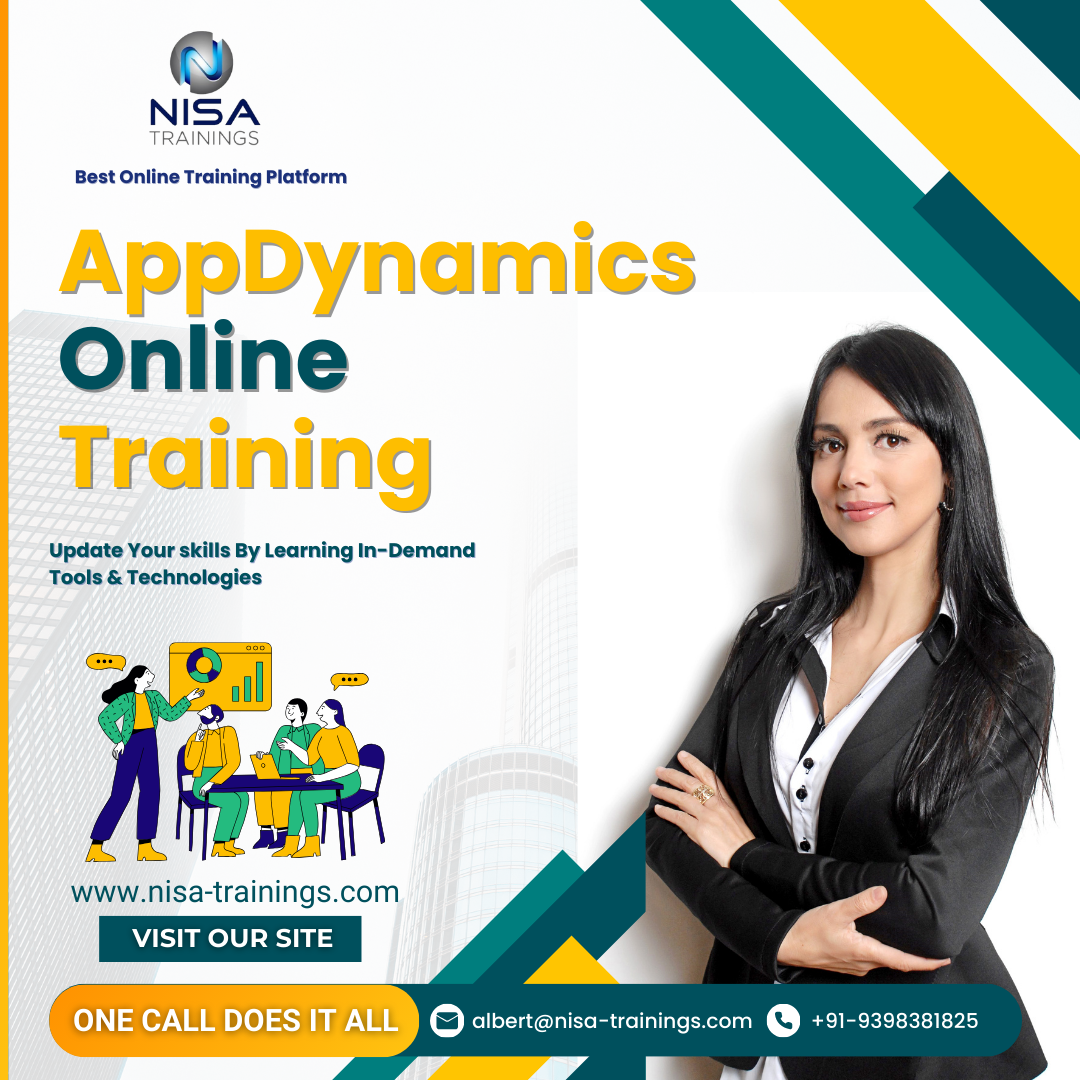Appdynamics Training
AppDynamics training provides a comprehensive learning experience designed to equip individuals with the skills necessary to effectively use the AppDynamics platform for monitoring and optimizing the performance of applications and infrastructure. The training is suitable for professionals in IT operations, DevOps, application developers, and system administrators who want to improve application performance management (APM) in their organizations.

Why should you choose Nisa For AppDynamics Training?
Nisa Trainings is the best online training platform for conducting one-on-one interactive live sessions with a 1:1 student-teacher ratio. You can gain hands-on experience by working on near-real-time projects under the guidance of our experienced faculty. We support you even after the completion of the course and happy to clarify your doubts anytime. Our teaching style at Nisa Trainings is entirely hands-on. You’ll have access to our desktop screen and will be actively conducting hands-on labs on your desktop.
Job Assistance
If you face any problem while working on AppDynamics Course, then Nisa Trainings is simply a Call/Text/Email away to assist you. We offer Online Job Support for professionals to assist them and to solve their problems in real-time.
The Process we follow for our Online Job Support Service:
- We receive your inquiry for Online Job
- We will arrange a telephone call with our consultant to grasp your complete requirement and the tools you’re
- If our consultant is 100% confident in taking up your requirement and when you are also comfortable with our consultant, we will only agree to provide service. And then you have to make the payment to get the service from
- We will fix the timing for Online Job Support as mutually agreed by you and our consultant.
Course Information
AppDynamics Training
Duration: 25 Hours
Timings: Weekdays (1-2 Hours per day) [OR] Weekends (2-3 Hours per day)
Training Method: Instructor Led Online One-on-One Live Interactive
Sessions.
COURSE CONTENT :
1. Introduction to AppDynamics (Foundational Level)
Overview of APM:
- What is Application Performance Management (APM)?
- Introduction to AppDynamics and its architecture.
- Key features and use cases of AppDynamics.
Installing and Setting Up AppDynamics:
- Installation of AppDynamics agents (Java, .NET, Node.js, etc.)
- Overview of Controller installation and configuration.
- Configuration of monitoring for different environments.
Navigating the AppDynamics User Interface:
- Introduction to the AppDynamics Controller UI.
- Overview of different dashboards.
- How to access and interpret performance metrics.
Introduction to Key Components:
- Application, Business Transaction, and Tier concepts.
- Setting up Business Transactions (BTs).
- Using Dynamic Baselines and Thresholds.
2. AppDynamics Core Concepts
Application Monitoring:
- Understanding application performance metrics (response time, throughput, error rate).
- Configuring automatic and manual Business Transaction detection.
- Deep dive into transaction snapshots and flow maps.
End-User Monitoring (EUM):
- Introduction to End-User Monitoring.
- Configuring Browser and Mobile RUM (Real User Monitoring).
- Understanding how to analyze and troubleshoot user experience issues.
Business Insights:
- How to use Business Transaction analytics to gain insights into application performance.
- Creating custom dashboards and reports for performance tracking.
3. Advanced Application Monitoring
Database Monitoring:
- Monitoring database performance (SQL, NoSQL, and external services).
- Understanding database query performance.
- How to troubleshoot slow or failing database queries.
Server Monitoring:
- Monitoring physical and virtual servers (CPU, memory, disk usage, etc.).
- Monitoring cloud environments (AWS, Azure, etc.).
- Integrating infrastructure monitoring with application monitoring.
Transaction Snapshots & Flow Maps:
- Analyzing and comparing transaction snapshots for performance bottlenecks.
- Utilizing Flow Maps to visualize application architecture and pinpoint performance issues.
4. Advanced Troubleshooting and Diagnostics
Root Cause Analysis:
- Using AppDynamics to detect and resolve performance issues (latency, errors, etc.).
- Understanding and applying custom diagnostic tools.
- Investigating slow response times, high CPU usage, and other bottlenecks.
Deep Dive into Diagnostics Tools:
- Transaction Diagnostic Snapshots.
- Comparing metrics over time for performance trends.
- Analyzing the flow of transactions to isolate root causes.
Code-Level Visibility:
- Configuring code-level diagnostics for Java, .NET, Node.js, and other technologies.
- Using AppDynamics to capture stack traces and performance data from within the code.
- Setting custom performance thresholds and alerts.
5. AppDynamics for Cloud and Microservices
Cloud Monitoring:
- Monitoring cloud-native applications (AWS, Microsoft Azure, Google Cloud).
- Handling dynamic cloud environments and auto-scaling.
- Integration with cloud services like Amazon RDS, DynamoDB, and S3.
Microservices Monitoring:
- Understanding microservices and how AppDynamics supports them.
- Using AppDynamics to monitor microservices running in containers (Docker, Kubernetes).
- Distributed tracing in a microservices architecture.
6. Customization and Automation
Alerting and Automation:
- Creating custom alert policies based on application and infrastructure performance.
- Setting up automated responses to performance issues.
- Integration with incident management systems (e.g., ServiceNow, Slack, Jira).
Custom Dashboards:
- Creating and sharing custom dashboards tailored to the application’s needs.
- Visualizing key performance metrics in real-time for stakeholders.
API Access and Integration:
- Using AppDynamics APIs for integration with third-party tools.
- Exporting performance data to other platforms for further analysis.
7. AppDynamics for Business and Performance Metrics
Business Transaction Analytics:
- Using Business Transaction (BT) analytics to correlate performance with business metrics.
- Understanding the impact of performance on user behavior and business outcomes.
Transaction Performance Optimization:
- Optimizing Business Transaction performance.
- Analyzing service dependencies and how they affect the application.
8. AppDynamics Security & Best Practices
- Security in AppDynamics:
- Securing the AppDynamics Controller and agents.
- Ensuring privacy and compliance when monitoring sensitive data.
- Best Practices for Implementation:
- Planning and architecting an AppDynamics deployment for large-scale applications.
- Best practices for ongoing monitoring, scaling, and troubleshooting.
